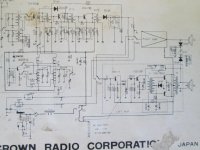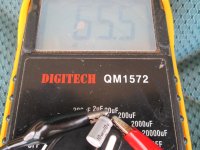I have a 1960s radio/record player I'm going to try to fix.Crown SPH-100.Would it be possible to swap out germanium's for silicon? I'm not too handy with circuit theory,I know just enough to be dangerous. This has a 4 transistor AM,SW radio plus 2 x 4 trans amplifiers with Hitachi HV16 and the radio has SD46 germanium diodes.Instead of having germanium trans 2SA350 and 2SA235 (detectors)in the radio as the schematic says this has AF124 geraniums in their place along with 2 x 2SA12s. The amplifiers have 2SB113,2SB75 and 2 x 2SB77s.If someone knows where I can get these germanium's or subs for a reasonable price that would make things easier.I measured the germanium's first in circuit using a DMM on diode setting and they came up alright but then I came across the ""proper way"" by setting the DMM on 2k ohms and it looks like most of them are R.S***?
Attachments
It might be possible to substitute silicon parts but there would need to be modifications too, to accommodate the high Vbe of 0.65V compared to germanium's ~0.25V. Not simple and probably unwise in the audio output stage, at least.
Substitutes or original Hitachi 2SB75 and 2SB77 are available on the net. - NTE have an equivalent for 2SB75 at least but I'm not sure what you mean by "reasonable" price. If you mean comparable with silicon prices, no, 'afraid they will cost $ but a lot less in time and $ than redesigning for silicon if your theory is not up to it.
http://www.nteinc.com/Web_pgs/Germanium.php?a=12
http://nte01.nteinc.com/nte%5CNTExRefSemiProd.nsf/$all/18A0D1E671A84CD885257910007EA762?OpenDocument
I think the value of old players like the Crown lies in the fact that that they are original Germanium and transformer coupled designs. Possibly, the transistors are only expensive because of postage and packing charges. Some types can be collectors' items and treasures for use in guitar effects boxes but most are available as surplus with very limited demand and fair selling prices.
Re testing: Not sure about resistance scale testing of germanium types. I don't think you could make any sense of it in-circuit though. An in-circuit tester such as the Peak Atlas or the clone from Altronics might be appropriate, if they do actually cover germanium types.
The first thing to do would be to replace every electrolytic capacitor with a value of 1-2 times the original and use a common voltage rating of 16 or 25V since modern parts are much smaller than those of 50 years ago. I'd be surprised if any had much capacitance at all and this will stop any device like the radiogram dead in its tracks.
I wouldn't look at replacements for transistors until after the re-cap, unless you are more certain of the test method. Germanium transistors do become leaky with age in use but you need a reference good part or specific data to determine that.
Substitutes or original Hitachi 2SB75 and 2SB77 are available on the net. - NTE have an equivalent for 2SB75 at least but I'm not sure what you mean by "reasonable" price. If you mean comparable with silicon prices, no, 'afraid they will cost $ but a lot less in time and $ than redesigning for silicon if your theory is not up to it.
http://www.nteinc.com/Web_pgs/Germanium.php?a=12
http://nte01.nteinc.com/nte%5CNTExRefSemiProd.nsf/$all/18A0D1E671A84CD885257910007EA762?OpenDocument
I think the value of old players like the Crown lies in the fact that that they are original Germanium and transformer coupled designs. Possibly, the transistors are only expensive because of postage and packing charges. Some types can be collectors' items and treasures for use in guitar effects boxes but most are available as surplus with very limited demand and fair selling prices.
Re testing: Not sure about resistance scale testing of germanium types. I don't think you could make any sense of it in-circuit though. An in-circuit tester such as the Peak Atlas or the clone from Altronics might be appropriate, if they do actually cover germanium types.
The first thing to do would be to replace every electrolytic capacitor with a value of 1-2 times the original and use a common voltage rating of 16 or 25V since modern parts are much smaller than those of 50 years ago. I'd be surprised if any had much capacitance at all and this will stop any device like the radiogram dead in its tracks.
I wouldn't look at replacements for transistors until after the re-cap, unless you are more certain of the test method. Germanium transistors do become leaky with age in use but you need a reference good part or specific data to determine that.
Last edited:
The first thing I did was replace the caps. Most were at least double their normal value? Only two were way down.It might be possible to substitute silicon parts but there would need to be modifications too, to accommodate the high Vbe of 0.65V compared to germanium's ~0.25V. Not simple and probably unwise in the audio output stage, at least.
Substitutes or original Hitachi 2SB75 and 2SB77 are available on the net. - NTE have an equivalent for 2SB75 at least but I'm not sure what you mean by "reasonable" price. If you mean comparable with silicon prices, no, 'afraid they will cost $ but a lot less in time and $ than redesigning for silicon if your theory is not up to it.
Germanium Transistor Selector Guide | NTE-Electronic Components Supplier
http://nte01.nteinc.com/nte%5CNTExRefSemiProd.nsf/$all/18A0D1E671A84CD885257910007EA762?OpenDocument
I think the value of old players like the Crown lies in the fact that that they are original Germanium and transformer coupled designs. Possibly, the transistors are only expensive because of postage and packing charges. Some types can be collectors' items and treasures for use in guitar effects boxes but most are available as surplus with very limited demand and fair selling prices.
Re testing: Not sure about resistance scale testing of germanium types. I don't think you could make any sense of it in-circuit though. An in-circuit tester such as the Peak Atlas or the clone from Altronics might be appropriate, if they do actually cover germanium types.
The first thing to do would be to replace every electrolytic capacitor with a value of 1-2 times the original and use a common voltage rating of 16 or 25V since modern parts are much smaller than those of 50 years ago. I'd be surprised if any had much capacitance at all and this will stop any device like the radiogram dead in its tracks.
I wouldn't look at replacements for transistors until after the re-cap, unless you are more certain of the test method. Germanium transistors do become leaky with age in use but you need a reference good part or specific data to determine that.
Attachments
I have a good range of AF type germanium transistors and OC type, all new old stock.
Thanks for that John,Ill check it out!
I have a good range of AF type germanium transistors and OC type, all new old stock.
I checked out your site John but all I could find was valves and a few guitar amplifiers for sale? How do I find out what you have in germanium transistors? Ive sent you a PM mentioning what I need.
The first thing I did was replace the caps. Most were at least double their normal value? Only two were way down.
Many caps are spec. at +200 -80% Now, of any electrolytic is over 7 to 10 years old, replace it. Value is not the only spec.
The AF series of transistors all to often succumb to a peculiar fate,
http://nepp.nasa.gov/whisker/anecdote/af114-transistor/index.html
http://nepp.nasa.gov/whisker/anecdote/af114-transistor/index.html
The use of no lead solder will have the same results eventually. You think no lead solder sucks now wait a few years.
Craig
Craig
I got your PM John,As I said before I measured the germanium transistors in circuit with a Digital multimeter and they all came up OK but because the radio wont work they obviously aren't OK? So I measured them again(in circuit)using a DMM set on 2k ohms,the radio transistors didn't register whatever way I measured them.Ive tapped and flicked them to see if they will burst into life but no luck with that.The only ones that might be OK are the 2SB77 = outputs on the amplifiers.Do you have a list of germanium's I can choose from or can you sub them for me?
The AF series of transistors all to often succumb to a peculiar fate,
http://nepp.nasa.gov/whisker/anecdote/af114-transistor/index.html
Thanks mate,that's interesting.I suppose its just pot luck with these NOS germaniums?
Thanks mate,that's interesting.I suppose its just pot luck with these NOS germaniums?
It would seem so. Its certainly a well recognised issue. The pdf link in that article is interesting.
Well, I don't know what happened with John,I thought he had some transistors to sell? Is there anyone else that has some germanium's laying around?
RS in UK had some at one time. Perhaps RS in Sydney can access them and handle the customs internally.
Then there is this guy in the USA: Vox Organ Germanium Transistors
I haven't used either one. I had a germanium transistor radio and the AM tuning wandered around all the time. Probably the temperature effect. I like silicon.
Then there is this guy in the USA: Vox Organ Germanium Transistors
I haven't used either one. I had a germanium transistor radio and the AM tuning wandered around all the time. Probably the temperature effect. I like silicon.
RS in UK had some at one time. Perhaps RS in Sydney can access them and handle the customs internally.
Then there is this guy in the USA: Vox Organ Germanium Transistors
I haven't used either one. I had a germanium transistor radio and the AM tuning wandered around all the time. Probably the temperature effect. I like silicon.
Thanks for the leads mate,Ill get on to them.Ive got some AF239 that according to my VRT comparison tables book is a sub for AF124 but the AF124 is FM-V 75mhz and AF239 is UHF-V/M/O 700mhz ? Ill try them and see what happens anyway?
- Status
- Not open for further replies.
- Home
- Amplifiers
- Solid State
- Swapping germanium for silicon transistors?

